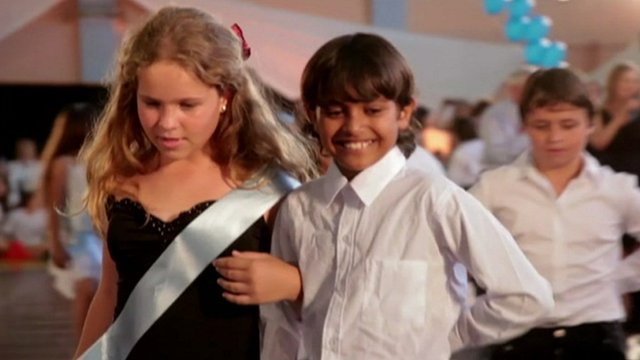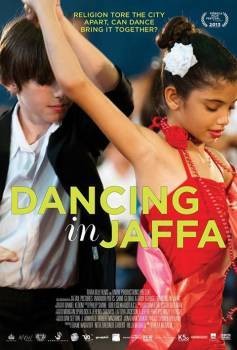 LOIS AND ALAABringing together "enemies" in dance
LOIS AND ALAABringing together "enemies" in danceHilla Medalia is an award-winning 36-year-old Israeli documentary filmmaker whose 2007
To Die in Jerusalem brought together in dialogue (by satellite) the mothers of two teenage girls paired on a
Newsweek cover, a Palestinian suicide bomber and an Israeli girl killed by her bomb. Her new film is about a less grim effort by famous ballroom teacher Pierre Dulaine to bring Jewissh and Palestinian kids together on the dance floor, and we see some little friendships and personalities bloom in his modest "peace process."
Jaffa, once a Palestinian town, is now a poor, mixed suburb of Tel Aviv. The intense 2009 joint Israeli- Arab feature film
Ajami focused on a rough part of Jaffa. In
Dancing in Jaffa, Hilla Medalia follows Pierre Dulaine as he goes back to Jaffa, where he was born in 1944, son of an Irish father and Palestinian mother. (In the film he never mentions that his mother was also half French, which explains "Pierre.") He has not been back since his family was driven out when he was a child. He comes to introduce to Palestinian-Israeli, Jewish-Israeli, and mixed schools in Jaffa his Dancing Classrooms, a social development program for fifth-graders that uses ballroom dancing "as a vehicle to change the lives of the children and their families" (Wikipedia). This time the primary "change" is the somewhat radical one of pairing Jewish and Arab girls and boys as dance partners.
In teaching gawky eleven-year-olds to dance, the pixieish Dulaine emphasizes etiquette, dignity, and respect from the get-go. He has to give up on one school because they boys won't dance. The more extreme muslim males won't touch girls, or at first refuse. Things don't go that well at first, and for a while Pierre brings over from the States his (dancing, not life) partner of 35 years, Yvonne Marceau. Their dancing together for the kids inspires them: you can see the boys' eyes light up; they are charmed.
Medalia follows several of the kids more closely, notably Noor, a plump, dark Palestinian girl whose grief over the death of her father makes her sullen, depressed, and sometimes violent. Alaa is a small boy who lives in a shack with his poor fisherman father. Alaa, dark and all smiles, and Lois, a curly-haired Jewish girl fathered out of a sperm bank, become partners for the upcoming dance contest, and their jaunt on Alaa's father's little rowboat heralds a budding friendship. But the real miracle is Noor, who shows rhythm and grace from the start, and whose selection for the competition is part of a reawakening and new happiness that you can't help being a little amazed by. Ah, fifth graders: this is the age when kids are most open and malleable.
The film shows other things, like Dulaine approaching his family's original residence and beating a hasty retreat when the current occupants are not just unfriendly but apparently downright hostile. Dulaine mostly speaks English, but he also speaks Arabic to the kids who understand Arabic. For Hebrew, he has an interpreter or the teachers translate for him. The schools he visits are Israeli-Palestinian, Israeli-Jewish, and mixed Palestinian-Jewish. There are seven different dances in the lessons and final contest, though merengue and rumba seem to predominate. At the final contest, all the parents are as excited as you'd expect. Each dance couple pairs a Palestinian and a Jew. And nobody seems to mind. At least for the moment, Dulaine has achieved reconciliation and crossed barriers that earlier, seemed uncrossable.
All this will be vaguely familiar, because you've probably seen a couple of other movies Pierre Dulaine inspired, the 2006 musical drama
Take the Lead, starring Antonio Banderas as Dulaine, and
Mad Hot Ballroom, a heartwarming and popular 2005 documentary about New York fifth graders who learn dance and take part in a dance contest. However,
Dancing in Jaffa prefers not to mention these, and alludes only vaguely to Pierre Dulaine's fame as a ballroom dancer when he partnered with Yvonne Marceau at Jacob's Pillow, on Broadway, and in London, or his having been on the faculties of the School of American Ballet, Alvin Ailey American Dance Theater, and the Juilliard School. This movie isn't about that. It's about little Jewish and Palestinian Israeli kids being polite and friendly and wiggling their hips gracefully together.
Dancing in Jaffa, a fairly simple and minimal film, isn't as priceless and cute or as proficiently made as
Mad Hot Ballroom. But the gaps it bridges are, of course, more significant.
Dancing in Jaffa, 84 mins., in Arabic, English, and Hebrew with English subtitles debuted in NYC in January 2013, and was included in the Tribeca and Sydney festivals. It has been picked up by Sundance Selects and a fall 2013 theatrical release is expected. Screened for this review as part of the San Francisco Jewish Film Festival (July 26-Aug. 10, 2013).






